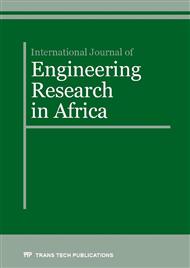[1]
N Savage and M.S. Diallo, Nanomaterials and water purification: Opportunities and challenges. Journal of Nanoparticle Research 7(2005) 331–342.
DOI: 10.1007/s11051-005-7523-5
Google Scholar
[2]
T. Pradeep, Anshup, Noble metal nanoparticles for water purification: A critical review. Thin Solid Films 517 (2009) 6441–6478.
DOI: 10.1016/j.tsf.2009.03.195
Google Scholar
[3]
C.B. Wang, Daniel Elliott, Y.P. Sun, Nanotechnology for Water Purification and Waste Treatment. Frontiers in Nanotechnology US EPA Millennium Lecture Series, (2005).
Google Scholar
[4]
V. Chandra, J. Park, Y. Chun, J.W. Lee, I.C. Hwang, K.S. Kim, Water-dispersible magnetite-reduced graphene oxide composites for arsenic removal, ACS Nano 4 (2010) 3979–3986.
DOI: 10.1021/nn1008897
Google Scholar
[5]
Y. Tanga, H. Guoa, L. Xiaoa, S. Yua, N. Gaoa, Y. Wang Synthesis of reduced graphene oxide/magnetite composites and investigation of their adsorption performance of fluoroquinolone antibiotics Colloids and Surfaces A: Physicochem. Eng. Aspects 424 (2013).
DOI: 10.1016/j.colsurfa.2013.02.030
Google Scholar
[6]
S.T. Yang, Y. Chang, H. Wang, G. Liu, S. Chen, Y. Wang, Y. Liu, A. Cao, Folding/ aggregation of graphene oxide and its application in Cu2+ removal, Journal of Colloid and Interface Science, 351(1), (2010), 122-127.
DOI: 10.1016/j.jcis.2010.07.042
Google Scholar
[7]
T. S. Sreeprasad, M. S. Maliyekkal, K. Deepti, K. Chaudhari, P. Lourdu Xavier, and T. Pradeep, Transparent, Luminescent, Antibacterial and Patternable Film Forming Composites of Graphene Oxide/Reduced Graphene Oxide ACS Appl. Mater. Interfaces 3, (2011).
DOI: 10.1021/am200447p
Google Scholar
[8]
R. Dreyer, Sungjin Park, Christopher W. Bielawski and Rodney S. Ruoff. The chemistry of graphene oxide, Chemical Society Reviews, 39, (2010), 228–240.
Google Scholar
[9]
C. Soldano, E. Dujardin, and A. mahmood. Production properties and potential of graphene. Carbon, 48(8) (2010).
Google Scholar
[10]
S. Bykkam, V. K Rao, S. Chakra and T. Thunugunta, Synthesis and characterization of graphene oxide and its antimicrobial activity against Klebseilla and Staphylococcus. International journal of Advanced Biotechnology and Research, 4(1), (2013).
Google Scholar
[11]
Y. Chang, H. Wang, S.T. Yang, G. Liu, S. Chen, Y. Wang, Y. Liu, A. Cao, Folding/aggregation of graphene oxide and its application in Cu2+ removal, Journal of Colloid and Interface Science, 351(1), (2010), 122-127.
DOI: 10.1016/j.jcis.2010.07.042
Google Scholar
[12]
J. Zhang, W. Shen, D. Pan, Z. Zhang, Y. Fang and M. Wu, Controlled synthesis of green and blue luminescent carbon nanoparticles with high yields by the carbonization of sucrose , 34(2010), 591–593.
DOI: 10.1039/b9nj00662a
Google Scholar
[13]
World Health Organization Guidelines for drinking-water quality [electronic resource], incorporating first addendum. Vol. 1, Recommendations. – 3rd ed. (2006), ISBN 92 4 154696 4.
Google Scholar
[14]
S. S. Gupta, T. S. Sreeprasad, S. M. Maliyekkal, S. K. Das, and T. Pradeep. Graphene from Sugar and its Application in Water Purification, India. American chemical society, 4 (8), (2012), 4156–4163.
DOI: 10.1021/am300889u
Google Scholar
[15]
K. Wang, L. Li, X. Wu, Synthesis of Graphene and Electrochemical Performance. J. Electrochem. Sci., 8 (2013) 6763 – 6766.
Google Scholar
[16]
W. Gao, M. Majumder, B. L. Alemany, T. N. Narayanan, M. A. Ibarra, B. K. Pradhan and P. M. Ajayan, Engineered Graphite Oxide Materials for Application in Water Purification. ACS Appl. Mater. Interfaces 3(2011), 1821–1826.
DOI: 10.1021/am200300u
Google Scholar
[17]
J. Bartram and S. Pedley, Water Quality Monitoring - A Practical Guide to the Design and Implementation of Freshwater Quality Studies and Monitoring Programmes. WHO (1989), No. 778.
DOI: 10.4324/9780203476796.ch2
Google Scholar
[18]
R. Das, M. E. Ali, S. B. A. Hamida, S. Ramakrishna , Z. Z. Chowdhury, Carbon nanotube membranes for water purification: A bright future in water desalination. Desalination 336 (2014) 97–109.
DOI: 10.1016/j.desal.2013.12.026
Google Scholar
[19]
V. Verma and A. Vidya. Arankalle, Virological evaluation of domestic water purification devices commonly used in India emphasizes inadequate quality and need for virological standards. Tropical Medicine and International Health 14 (8), (2009).
DOI: 10.1111/j.1365-3156.2009.02318.x
Google Scholar


